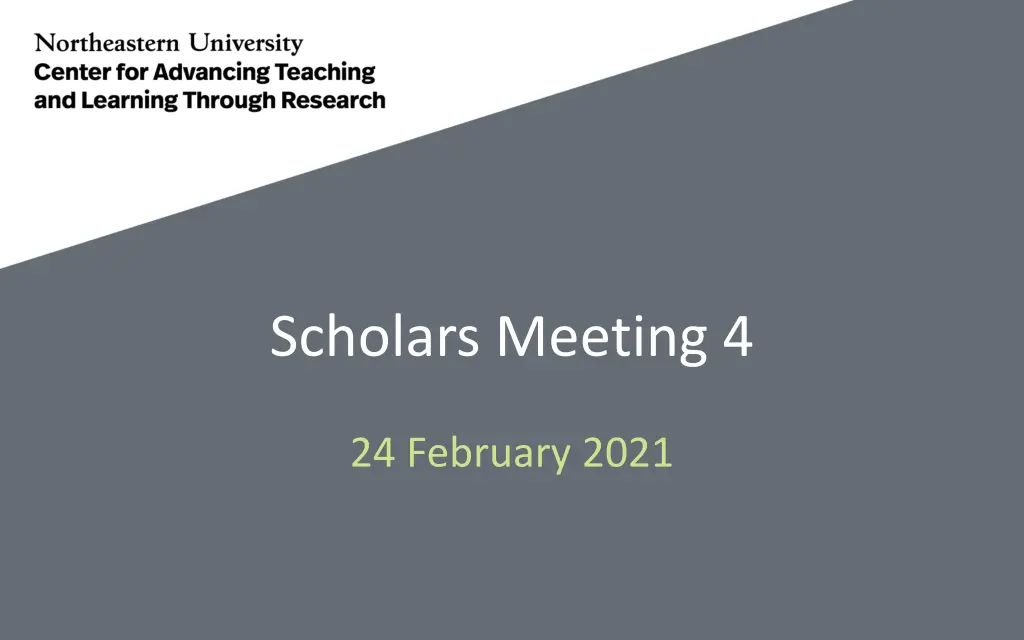
Exploring Alignment in Scholarship of Teaching and Learning (SoTL)
Join the Scholars Meeting to delve into the concept of alignment in SoTL research, focusing on learning objectives, evidence of learning, and instructional activities. Discover how to tweak research questions, gather evidence, and implement instructional strategies effectively. Constantine and Brooke's questions provide insights into visualizing arrays and practicing decision-making skills in educational settings.
Download Presentation

Please find below an Image/Link to download the presentation.
The content on the website is provided AS IS for your information and personal use only. It may not be sold, licensed, or shared on other websites without obtaining consent from the author. If you encounter any issues during the download, it is possible that the publisher has removed the file from their server.
You are allowed to download the files provided on this website for personal or commercial use, subject to the condition that they are used lawfully. All files are the property of their respective owners.
The content on the website is provided AS IS for your information and personal use only. It may not be sold, licensed, or shared on other websites without obtaining consent from the author.
E N D
Presentation Transcript
Scholars Meeting 4 24 February 2021
Todays Agenda Explanation of alignment in SoTL 11:50 Example of thinking about alignment 11:55 12:30 Thinking through alignment with Constantine s question Thinking through alignment with Brooke s question 12:50 Where we are in the SoTL Journey 1:00 Next Time 1:10
Constructive Alignment Learning objectives What should students know or be able to do? Evidence of learning How will you know if students meet the objectives? Instructional activities How will students get there?
Alignment in SoTL Research question What phenomenon about learning to you want to examine? Evidence What data will help you answer your question? Instructional activities What activities will produce the evidence you need?
Example How could I tweak my question to be more researchable? What evidence is already being produced in my class? Research question How do students understandings of the concept of shared governance change when they ? governance more accurately? How can I get students to understand the concept of shared Evidence Pre and post written explanation of shared governance Concept maps What could I change in my teaching to produce the evidence I need? Readings that focus on shared governance as a concept, not just the separate players in shared governance. Concept map assignment Instructional activities
Constantines question Research question How do students visualize and understand arrays? Do students understand conceptually or technically? Evidence / Data --individual assignments --may or not be able to tell how they visual and understand arrays --draw/illustrate the array then compare to translation in program Instructional pathway: --moving from single object to multiple --draws table, asks students how to access elements --add indices for rows and columns --go through program together --apply in individual assignments Instructional activities
Brookes question Research question How do students practice decision- making skills and comfort with ambiguity in a FYS course to make meaning of their college experience? Evidence -- pre and post Me plan (strategic plan for academic & experiential engagement) -- paper and presentation -- reflections based on specific activities -- threshold concept: major does not define career -- activities matching major and career where some answers are not expected -- students get idea but don t apply to exploration Instructional activities
Steps in the Journey Identify Question Situate Yourself Enrich Question Focus Investigate (Adapted from Takayama, 2017)
Engaging in the SoTL Journey Components Pose questions about your students learning Identify assumptions about your discipline and your students learning Identify Question Situate Yourself Possible Actions Engage in informal conversations with colleagues about your questions Decode your discipline Articulate organizational structures or knowledge maps Enrich Question Focus Investigate (Adapted from Takayama, 2017)
Engaging in the SoTL Journey Components Heightened, grounded awareness of what is Sense of who is doing work that might relate to your question Mental model of how your question relates to theory and research related to learning Identify Question Situate Yourself Enrich Question Possible Actions Author a thick description of the learning scenario Identify key phrases/terms related to your questions Connect questions to learning processes and knowledge classifications Review literature (go beyond your discipline, institutional, and national context)(Adapted from Takayama, 2017) Focus Investigate
Engaging in the SoTL Journey Components Map of relevant evidence and data Survey potentially pertinent study approaches Potential collaborators Identify Question Situate Yourself Possible Actions Refine question into a meaningful problem Identify artifacts, already generated by the learning experience, that could provide insight into the problem Consider additional evidence to collect or observe that would also illuminate the problem Revisit SoTL and disciplinary literature to explore methodologies (cast a broad net) Enrich Question Focus Investigate (Adapted from Takayama, 2017)
Next Time Use the handout to author a thick description of the learning scenario that gives rise to your problem/curiosity. Post the thick description in your portfolio by Monday, March 8, and post it in your portfolio. Go into your colleagues portfolios and read their thick descriptions before we meet on Wednesday, March 10.






















